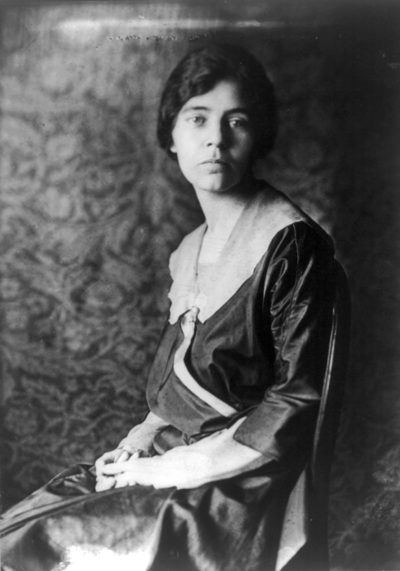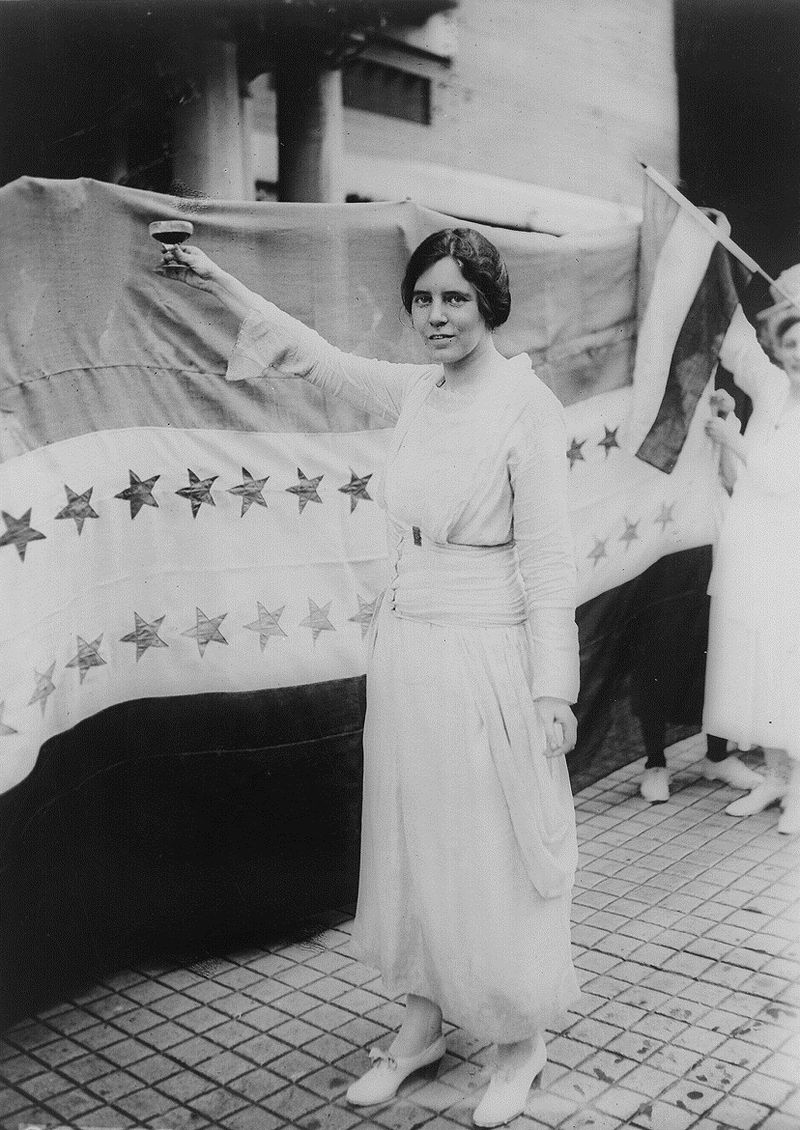Alice Paul (Alice Paul)

In 1907, after completing her master’s degree at the University of Pennsylvania, Alice Paul moved to England where she eventually became deeply involved with women suffragists and their work. Paul encountered Emmeline and Christabel Pankhurst, the militant founders of the Women’s Social and Political Union (WSPU) in Britain. Through working with these women Paul determined that social work could not bring about the changes in the status of women that she wanted. Militant activism became her vocation. After a “conversion experience” seeing Christabel Pankhurst speak at the University of Birmingham, Paul realized that radical reform was what the world needed, not slow changes to the status quo – and that was to be found in the political power of woman suffrage, which would enable women of all stripes to enact reforms to better their lot. When she later moved to London, Paul joined the WSPU and, in 1909, began participating in demonstrations and marches. While associated with the WSPU, Paul was arrested seven times and imprisoned three times, and participated in hunger strikes while in prison. Alice Paul met Lucy Burns during a London march led by Emmeline Pankhurst, at which all of the participants were arrested. They continued to work together in the WSPU, and the relationship would continue for the duration of the suffrage fight, first in England, then in the United States. In August 1909, Paul accepted an organizer’s job in the WSPU and was sent to various cities to prepare the ground for demonstrations and symbolic events. Paul put herself physically on the line during dramatic attempts to increase the visibility of the women’s cause. Before a political meeting at St. Andrew’s Hall in Glasgow in August 1909, Paul camped out on the roof of the hall so that she could address the crowd below. She was cheered by the crowd as police forced her to come down; later, when Paul, Burns, and fellow suffragists attempted to enter the event, they were beaten by police while sympathetic bystanders attempted to protect them.
During the autumn of 1909, Alice Paul and another suffragist, Amelia Brown, disguised themselves as cleaners at the Guildhall, where the Lord Mayor was hosting a banquet for Prime Minister Asquith and other cabinet ministers. When Asquith stood up to speak, Paul and the other suffragist threw their shoes and broke stained glass windows in order to gain attention, while screaming “Votes for women!”. The women were arrested and sentenced to one month’s hard labor. During previous arrests, Paul had secured a quick release by going on hunger strike, but during this incarceration, she was force-fed, a process which caused great bodily harm. Paul had to be carried out of the prison at the end of her sentence. After the ordeal of her final London imprisonment, Paul returned to the United States in January 1910 to continue her recovery and to develop a plan for suffrage work back home.[9] Paul’s experiences in England were well-publicized, and the American news media was already covering her activities while she was still in London. She knew that she was positioned to bring greater attention and scrutiny to the woman suffrage cause, and used this power to shake up the stagnant American suffrage movement. Alice Paul re-enrolled at the University of Pennsylvania, pursuing her Ph.D., while speaking about her experiences in the British suffrage movement to Quaker audiences and starting to work in United States suffrage on the local level. After completing her dissertation, a comprehensive overview of the history of the legal status of United States women, she began participating in National Woman Suffrage Association (NAWSA) rallies, and eventually moved to Washington to chair NAWSA’s Congressional Committee. NAWSA’s work at the time was primarily focused at the state level; the passage of a congressional amendment seemed like an insurmountable challenge given the truculent opposition of the South and Northeast.
One of Alice Paul’s first big projects was initiating and organizing the 1913 Woman Suffrage Procession in Washington the day before President Wilson’s inauguration. Paul was determined to put pressure on Wilson, because the President would have the most influence over Congress. Paul assigned volunteers to contact suffragists around the nation to ask supporters to come march in Washington. In just weeks, Paul had organized eight-thousand marchers representing multiple states in the country. Multiple bands, banners, squadrons, chariots, and floats were displayed in the parade representing all women’s lives gathered at the nation’s capital. The lead banner in the parade said, “We Demand an Amendment to the United States Constitution Enfranchising the Women of the Country.” Over half a million people came to view the parade; with insufficient police protection, the situation soon devolved into a near-riot, with onlookers pressing so close to the women that they were unable to proceed. The Massachusetts and Pennsylvania national guards stepped in; eventually, students from the Maryland Agricultural College provided a human barrier to help the women pass. The incident mobilized public dialogue about the police response to the women’s demonstration, producing greater awareness and sympathy for NAWSA. After the parade, the NAWSA’s focus was lobbying for a constitutional amendment to secure the right to vote for women. Such an amendment had originally been sought by suffragists Susan B. Anthony and Elizabeth Cady Stanton who, as leaders of the NWSA, fought for a federal amendment to the constitution securing women’s suffrage until the 1890 formation of NAWSA, which campaigned for the vote on a state-by-state basis. Alice Paul continued fighting for equal rights until she suffered a debilitating stroke in 1974. She died at the age of 92 on July 9, 1977 at the Greenleaf Extension Home, a Quaker facility in Moorestown, New Jersey, less than a mile from her birthplace and childhood home at Paulsdale.
Born
- January, 11, 1885
- USA
- Mount Laurel Township, New Jersey
Died
- July, 09, 1977
- USA
- Morristown, New Jersey
Cemetery
- Westfield Friends Burial Ground
- Cinnaminson, New Jersey
- USA



